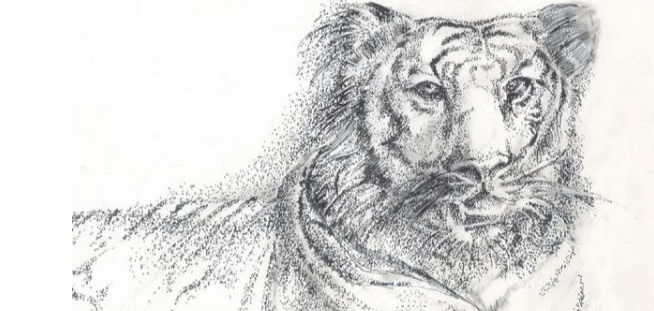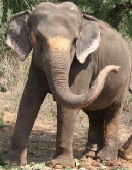The state of Andhra Pradesh is blessed with an environment with wide variations. Its range varies from high ranges of Eastern Ghats to the shores of mighty oceans and lively rivers. Its rich Flora and Fauna are to be seen to be believed.The very fact that the state of Andhra Pradesh is endowed with a plethora of National Parks. Bird Sanctuaries and wildlife sanctuaries speaks volumes about the states enriched Natural treasure chests.
This natural bounty has helped Andhra Pradesh in a big way in earning a considerable amount of revenue through APTDC, Andhra Pradesh tourism development corporation. Its not all, these natural resources provided many employment opportunities.
 Nehru Zoological Park
Nehru Zoological Park
Its the largest Zoological park in India. This park is located around 8 Km to the south of Charminar near Mir Alam tank.. Nehru Zoological Park houses more than 250 species of animals and birds. Nehru Zoological park is a sprawling verdant green park with an area of 300 acres. The park includes birds, animals and reptiles along with the animals like Indian Rhino, Asiatic lion, tiger panther, Gaur, Orangutan, crocodile, python, deers, Kangaroos, antelopes and birds.
Kawal Sanctuary
Kawal Sanctuary is located in Adilabad district occupying an area of 893 sq.km. This sanctuary is endowed with rich flora and fauna. Deciduous Teak forests. Kawal sanctuary is the abode for exotic Tiger, Panther, Gaur, Cheetal, Sambar, Nilgai, and a huge variety of Birds.
Nagarjunasagar- Srisailam Sanctuary(Project Tiger)
This sanctuary spreads over the districts of Guntur. Prakasam,Kurnool, Mahaboobnagar and Nalgonda districts occupying an area of 3568 sq. km.
Nagarjunasagar- Srisailam Sanctuary's rich Flora and Fauna is mind boggling. The sanctuarie's dry deciduous forests form deep gorges and valleys. This sanctuary is a habitat for Tigers, panther, Sloth bear to name a few.
 Kaundinya Sanctuary (Project Elephant)
Kaundinya Sanctuary (Project Elephant)
Located in Chittoor district, occupying a vast area of 358 km, Kaundinya Sanctuary is endowed with a rich treasure of Flora and Fauna. Its a habitat for Indian Elephant, sloth bear, panther, cheetal, jackal, jungle fowl and slender Loris.
A decade ago, a good number of elephants started a journey in search of a habitat and other alternate places from the forests of Tamilnadu and Karnataka. In this process a good number of Elephants entered the state of Andhra Pradesh, where there was no elephant population at all earlier.
This made the forest officials of Andhra Pradesh think and set up a sanctuary to the elephants.
Thus Kaundinya sanctuary for the pachyderms came in to existence. Today Kaundinya sanctuary is rich by 72 elephants.
 Kolleru Sanctuary
Kolleru Sanctuary
Kolleru sanctuary is located in West Godavari distrrict occupying an area of 673 sq.km. Kolleru lake is the second largest fresh water lake in the state. The magic of Kolleru lake is, it not only draws a huge number of tourists all along the year, it has become a favourite haven for exotic migratory birds especially in winter like Siberian crane, Ibises and painted storks.
Kolleru lake spreads in to two districts of West Godavari and Krishna. Budameru and Tammileru streams feed water to Kolleru lake.
Kolleru lake is a habitat not only for migratory birds during winter, but also for millions of domestic birds too. In the year 2002,under the international Ramsar convention, Kolleru lake was designated as "Wetland of International importance."
Pulicat Sanctuary
Its the second largest brackish water eco-system in India after the Chilika lake in Orissa. Located in Nellore district with an area of 500 sq.km Pulicat sanctuary is enriched with a unique flora and Fauna, especially Greater Flamingos. Because of its exceptional bio-diversity, Pulicat sanctuary is able to attract a large number of visitors every year. The Pulicat sanctuary is a great contributor to the economy of the state of Andhra Pradesh.
Rollapadu Sanctuary
Locate4d in the Kurnool district and occupying an area of 6.14 sq.km area, Rollapadu Sanctuary is the house for the most endangered species, Great Indian Bustard. Besides Great Indian Bustard, Rollapadu sanctuary houses Black Buck, Indian Macaque, Indian roller, Russell's viper, Indian Cobra are some of the species. This sanctuary is about 60 km from Kurnool and near Nandikotkur.
Nelapattu Sanctuary
This sanctuary attracts migratory birds specially PELICANS from Antarctica, USA and many more far off places. A unique quality in Nelapattu sanctuary is, it is the habitat for water flooded forest tree species. It means these trees can survive even if the tree is submerged under water for longer time. They can survive under water even in the extreme flood conditions for longer periods. These trees grown only in Nelapattu Sanctuary.
Sri Lankamalleswara Sanctuary
Sri Lankamalleswara Sanctuary is located in Cuddapah district with an area of 464 sq.km. Its Flora and Fauna can be seen in this sanctuary through more than 1400 plant species. Red Sanders is a special type of Teak is grown in this area. Its the habitat for the rare and endangered species "Jerdon's courser
Kinnerasani Sanctuary
Located in the khammam district with an area of 656 sq.km, Kinnerasani Sanctuary houses a variety of species of birds and animals. River Kinnerasani flows through the sanctuary and finally meets river Godavari. Hence the name of Kinnerasani name for this sanctuary. The Fauna of Kinnerasani sanctuary consists of Cheetal, Chinkara, Chousingha, sambar to name a few. Like the Fauna, Kinnerasani's flora is also exotic. Species like Bamboo, Teak, Maddi, Yepi, Yegissa, Sommi Thandra are but a few varieties of Flora one can see in Kinnerasani Sanctuary.
Pranahita Sanctuary
Located 35 km from Manchiriala, Adilabad district. Pranahita Sanctuary is endowed with rich flora and fauna. Pranahita sanctuary is the abode for natural vegetation. Plant species like ptero carpus,Marsupium,dalbergia panculata to name a few can be found here.When it comes to Fauna, its as impressive as Pranahita's Flora. Tigers, leopards, rhesus, laqngurs, hyenas are some of the wildlife species, a visitor can encounter with. Pranahita sanctuary boasts of an array of exotic bird species like Strokes, teals,ducks and herons.
Sivaram Sanctuary
Spread in two districts, Adilabad and Karimnagar districts Sivaram Sanctuary has an area of 37 sq. km. Sivaram Sanctuary ic endowed with Riverine forest. A riverine forest is a forest that is based on the banks of a river. The tree species like Teak and Terminalia are some of the examples of Sivaram Sanctuary's exotic Flora. Its noted for crocodiles in river Godavari.
Eturunagaram Sanctuary
Eturunagaram sanctuary is located in Warangal district occupying an area of 806 eq.km.Its flora consists of dry deciduous Teak forest with Bamboo, Buchnania etc. Eturunagaram's Fauna consists of Tiger, pnther, Sambar, cheetal, Nilgai, blackbuck, Chowsingha, barking deer etc.
Gundla Brahmeswaram Sanctuary
Situated on the borders of Kurnool and Prakasam distrricts, Gundla Brahmeswaram Sanctuary is 30 km away from Nandyala railway station, This sanctuary which occupies an area of 1194 sq.kn is blessed with a rich flora of mixed deciduous forests of Teak,Pterocarpus, terminalia, Albizzia, Anogeissius, Dalbergia, Boswellia, Shishum. Andug and Bamboo. River Gundlakam,ma flows through Gundla Brahmeswaram Sanctuary.
Gundla Brahmeswaram Sanctuary includes a variety of Fauna. Tiger, panther,sloth bear, wild dog. Hyena, jungle cat,Mouse deer, Monitor lizard, Antelope, Chinkara and many more.
Out of this grand list of Gundla Brahmeswaram Sanctuary's fauna, Mouse deer and tufted grey Langur stand out as the primary attractions of the samctuary.
Pakhal Sanctuary
Covering an area of 879 sq.km of undulating forest land, hills and dales, Pakhal samctuary is located about 50 kn away from Warangal. Pakhal samctuary consists of dry deciduous teak forests, Bamboo.Madhuca, Terminalia. Pterocarpus etc. The famous Pakhal lake is located in Pakhal lake is a big tourist attraction. it was constrcted in 1213 by ruler from Kakatiya dynasty.
Pakhal sanctuary houses Tiger, panther, Gaur, Sambar, Neelgai, Cheetal, wild boar, sloth bear, wild dog, Hyena, Fox, Jackal and a plethora of exotic birds like Ibises,, Teals, storks and cormorants.
Coringa Wildlife Sanctuary
Coringa Wildlife Sanctuary is the second largest mangrove forests in India. Coringa Wildlife Sanctuary is blessed with 24 mangrove tree species, 120 bird species. Coringa Wildlife Sanctuary shelters the 2 endangered species, white backed vulture and long billed vulture.
Coringa Wildlife Sanctuary is located 18 km from Kakinada and is a part of the Godavari estuary and is very rich in mangroves. Besides this there are 35 species of plants belonging to 24 families.
Papikonda sanctuary
Spread over East Godavari, West Godavari and Khammam districts, Papikonda sanctuary occupies an area of 591 km.
Papikonda sanctuary comprises of dry deciduous teak forests with bamboo, terminalia,Pterocarpus to name a few. Papikonda Sanctuary has an equally impressive Fauna tucked under its belt.Animals in the sanctuary are Tiger, Panther, Gaurm cheetal Chousingha, Sam,bar, blackbuck, Mouse deer, Barkig deer, Sloth bear, wild dog to name a few.
Manjira wild life sanctuary
Originally Manjira wildlife sanctuary was a crockodile sanctuary. Now it has an enviable 70 species of birds. Manjira wildlife sanctuary is a reservoir also which serves drinking water to Hyderabad and Secunderabad. Manjira wildlife sanctuary is home for the endangered species of Mugger Crocodile.
Located in Medak district, Manjira wildlife sanctuary's reservoir contains 9 small islands which contain marshy fringes. These marshy fringes are the favorite havens for water birds for nesting.
Stress on Crocodiles
In the year 1974 there was an alarming fall in the Mugger crocodile population. In a bis to conserve the crocodile species. the Andhra Pradesh government started a crocodile sanctuary. In 1980s, Manjira has become a most visited and favorite haven for bird watchers. This finally led to formation of a wildlife sanctuary.
Now this sanctuary is rich by 3oo crocodiles.
Pocharam wildlife sanctuary
Located at a distance of 15 km from Medak Pocharam forest was a hunting ground for the Nzam. The Nizam declared it as early as in the early part of 20th century as Pocharam wildlife sanctuary.
The main attraction of Pocharam wildlife sanctuary is its Eco - tourism center. Visitots can see five species of Antelopes and deers.
National Parks in Andhra Pradesh
Kasu BrahmanandaReddy National Park
Located at Jubilee Hills, Hyderabad, the state capital occupies 1.45 sq. km. Thus park houses the famous Chiran palace. The Chiran palace includes Mor Bungalow,Gol Bungalow and Notor khana. In the year 1998, the whole complex has been declared as the National park status by the state government of Andhra Pradesh.
In this national park, no big animals are kept except a few species of birds. This park serves as a good escape to the people of Hyderabad as a good relaxing spot for those who want to have a breather after a day's hectic city life.
Mrugavani National Park, Chilkur
Its located near Chilkur, Moinabad mandal, near Hyderabad, the state capital. It occupies an area of 3.65 sq.km. Chilkur, where Mrugavani National park is located is also famous for Chilkur Balaji temple. Mrugavani National park contains 600 varieties of exotic plant species. Mrugavani National park's flora includes Teak, Bamboo and sandalwood among many species. Cheeta, Sanmbar, wild boar, Russell wiper, Python and Mongoose are some of the species of Fauna of Mrugavani National park.
Mahavir Harina Vanasthali National park
Its a deer National park located in Vanasthalipuram a subarb of Hyderabad, the state capital of Andhraradesh. Un the year 1975, in commemoration of Mahavir's 2500th birth anniversary, the Jain Saint. Before the birth of Mahavir Harina Vanasthali National park.this place was the hunting ground for the rulers of Hyderabad.
Visuals : paintings of the author, Wiki commons